Art of the Genre: The Top 10 RPG Artists of the Past 40 Years
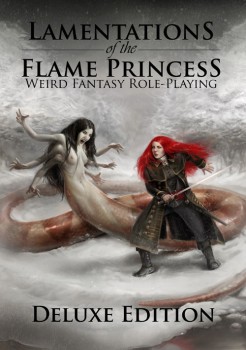
The office here at Black Gate L.A. has never been quiet, it just isn’t who we are. But with the addition of new blogger James Maliszewski to the mix, it is downright loud. This change was made all the more punctuated today by the fact that our southern California drought was broken with a series of showers. As I didn’t want to get damp, I was forced to close the windows to my corner office, which usually provide some calming background noise from the crashing waves and calling gulls on Redondo Beach. Now closed in, and facing a deadline, I had to fight against the sound of a debate between Maliszewski and Ryan Harvey on who would best portray adventuring party characters in a film version of Lamentations of the Flame Princess.
Honestly, I would have cast our resilient secretary, Kandi, for the lead as she often times dyes her hair red when the mood strikes, but these two ‘A list’ diehards had no interest in my two cents. Therefore, I read over an email once more from our intrepid editor, John O’Neill, which I’d received the Friday before.
Taylor, I’m not paying you six figures to get a tan, so write me some numbers-generating copy!
Nice… Always the charmer that one.
Nonetheless, I flipped on my computer with my sexy desktop background of our very own Sue Granquist lounging around in her ‘Goth Chick’ black, white, and buckled finery and then bumped over to Microsoft Word. What to write? Well, how about a ‘Top 10’, since those seem to always create a buzz and get people to click down after the break.
Considering the Lamentations of the Flame Princess argument, and the just-passed 40th Anniversary of Dungeons & Dragons, I decided on the ‘Top 10 RPG Artists of All-Time.” Yep, I think I’m qualified to take that one on, but just to discourage my own favoritism, I decided on a way to judge the list outside my own nostalgic mind. Now sure, the below rules have some level of interpretation on my end, but I do believe they hold water for overall impact on the industry.
How did I judge? Well, I broke things down into six different qualification categories, but as I was under a deadline, I decided not to dig deeper than that and had to go with my gut on tiebreakers. Still, the list grew beyond a simple ‘Top 10’ so enjoy the expanded list and let me know what you think.
Oh, and here are the overarching criteria.
1. Did they define a gaming line? Meaning, did they have a large impact on a whole line, doing a significant amount of work in it.
2. Is one of their pieces a seminal work in the industry? This is subjective on my part, but did they do a piece you could put up without graphics that 8 out of 10 gamers could tell you the game it represented.
3. Has their work appeared in three game lines and three distinct companies? This was a tough one, but I decided to truly have an impact they needed to have significant bit of work or defining piece in unique game lines from industry companies that were above ‘garage works’. Thus, you couldn’t milk one big company your whole career and get this ‘point’.
4. Has their presence lasted inside the industry for more than a decade? Easy enough, have they done RPG work that has been released over 10 years apart during their tenure.
5. Even if not known by name, is their style unique enough that it is readily identifiable above the background noise of the industry as a whole? Again, subjective, but does their artwork make 8 out of 10 gamers say, ‘Yes, I know that artist, they did blah’.
6. Did a company build their brand around them? The final key, did the artist get the ‘core’ release cover for any line. This means the company through they were important enough to cover the initial release and sell boatloads of copies.
So, with those established, here is the list I came up with.
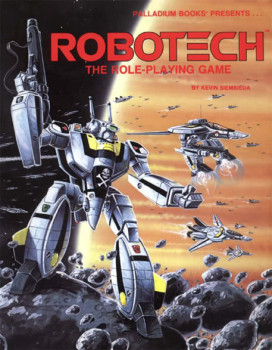 Honorable Mention #2: Kevin Long: Kevin isn’t an name that often comes up in conversations about fantasy artwork, and I’ve even heard tell that people he’s worked with for years at his current company don’t even know he is/was an gaming artist, but nonetheless Kevin’s work helped another Kevin, that being Kevin Siembieda, create the artistic brand for the multiple universes of Palladium’s gaming line. Now certainly Palladium, like most smaller houses, has used a plethora of freelance artists over the years, and Parkinson’s work on the cover of Rifts is probably their most well-known image they’ve done, but Long gets the nod here for both is proliferation in those various lines and of course his work as the singular voice for the Robotech RPG. Robotech, even above Rifts in my mind, reflects the soul of Palladium, and over the course of three decades Long’s work has helped bring the fabled Japanese animation series into the forefront of American science fiction role-playing.
Honorable Mention #2: Kevin Long: Kevin isn’t an name that often comes up in conversations about fantasy artwork, and I’ve even heard tell that people he’s worked with for years at his current company don’t even know he is/was an gaming artist, but nonetheless Kevin’s work helped another Kevin, that being Kevin Siembieda, create the artistic brand for the multiple universes of Palladium’s gaming line. Now certainly Palladium, like most smaller houses, has used a plethora of freelance artists over the years, and Parkinson’s work on the cover of Rifts is probably their most well-known image they’ve done, but Long gets the nod here for both is proliferation in those various lines and of course his work as the singular voice for the Robotech RPG. Robotech, even above Rifts in my mind, reflects the soul of Palladium, and over the course of three decades Long’s work has helped bring the fabled Japanese animation series into the forefront of American science fiction role-playing.
Did you define a gaming line? Yes, Robotech – Palladium
Is one of your pieces a seminal work in the industry? No
Has your work appeared in three game lines and three companies? No
Has your presence lasted inside the industry for more than a decade? Yes [1986-Present]
Even if not known by name, is your style unique enough that it is readily identifiable above the background noise of the industry as a whole? No
Did a company build their brand around you? Yes, Robotech – Palladium
Final Rating: 3 out of 6
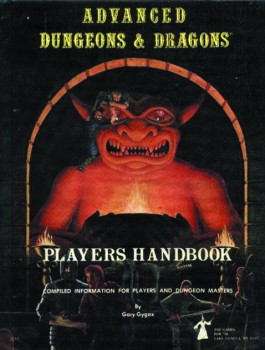 Honorable Mention # 1: Dave Trampier: Trampier is an interesting study, because although he did do some good interior black & white work, especially on the TSR Star Frontiers line, he is mostly known for two things, the original AD&D Player’s Handbook cover and the wrap painting for the original Dungeon Master’s Screen. Other than Wormy, which appeared for many years in Dragon, Tramp’s impact on the industry is minimal for the amount of lore surrounding him. To many, he is the ‘great white whale’ of gaming art, the man who disappeared and was never seen again no matter who went searching. To me, there was no one in the early TSR art department with half the pure talent of Trampier, apologies to Dee, Willingham, Otus, Darlene, and the late Jim Roslof, but Trampier had a depth that none of the others ever managed. To me it was as though he sat just on the edge of becoming the next great fantasy artist of his generation, but then he was gone.
Honorable Mention # 1: Dave Trampier: Trampier is an interesting study, because although he did do some good interior black & white work, especially on the TSR Star Frontiers line, he is mostly known for two things, the original AD&D Player’s Handbook cover and the wrap painting for the original Dungeon Master’s Screen. Other than Wormy, which appeared for many years in Dragon, Tramp’s impact on the industry is minimal for the amount of lore surrounding him. To many, he is the ‘great white whale’ of gaming art, the man who disappeared and was never seen again no matter who went searching. To me, there was no one in the early TSR art department with half the pure talent of Trampier, apologies to Dee, Willingham, Otus, Darlene, and the late Jim Roslof, but Trampier had a depth that none of the others ever managed. To me it was as though he sat just on the edge of becoming the next great fantasy artist of his generation, but then he was gone.
Did you define a gaming line? Yes, AD&D [1st Edition] – TSR
Is one of your pieces a seminal work in the industry? Yes, AD&D Players Handbook [1st Edition] – TSR
Has your work appeared in three game lines and three companies? No
Has your presence lasted inside the industry for more than a decade? No [1977-1985]
Even if not known by name, is your style unique enough that it is readily identifiable above the background noise of the industry as a whole? No
Did a company build their brand around you? Yes, AD&D Player’s Handbook [June 1978] – TSR
Final Rating: 3 out of 6
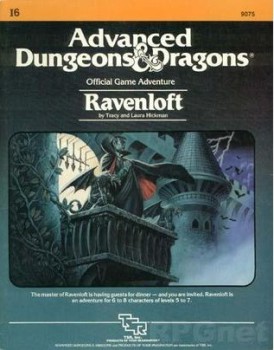 9C. Clyde Caldwell: Clyde gets his inclusion on this list for a couple of reasons, the primary of which is he was in the right place at the right time. That isn’t a knock on Clyde’s talent as an artist, but simply by being one of TSR’s ‘Big Four’ of the 1980s, like how Ringo Starr gets into the Rock & Roll hall of fame for being a Beatle, it is a huge leg up on your resume. Still, Clyde took great advantage of his place and offered up a great deal of sublime and lasting work, although he was never really one to go outside of TSR even after he left the company, although like many he went into covering novels.
9C. Clyde Caldwell: Clyde gets his inclusion on this list for a couple of reasons, the primary of which is he was in the right place at the right time. That isn’t a knock on Clyde’s talent as an artist, but simply by being one of TSR’s ‘Big Four’ of the 1980s, like how Ringo Starr gets into the Rock & Roll hall of fame for being a Beatle, it is a huge leg up on your resume. Still, Clyde took great advantage of his place and offered up a great deal of sublime and lasting work, although he was never really one to go outside of TSR even after he left the company, although like many he went into covering novels.
Did you define a gaming line? Yes, Basic D&D Mystara Gazetteers – TSR
Is one of your pieces a seminal work in the industry? Yes, I6 Ravenloft – TSR
Has your work appeared in three game lines and three companies? No
Has your presence lasted inside the industry for more than a decade? Yes [1983-Present]
Even if not known by name, is your style unique enough that it is readily identifiable above the background noise of the industry as a whole? No [often mistaken for Elmore]
Did a company build their brand around you? Yes, Ravenloft – TSR
Final Rating: 4 out of 6
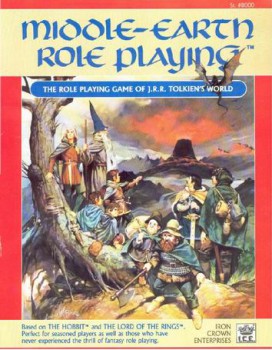 9B. Angus McBride: Angus might not be a household name, and in some circles people don’t even realize that the master of Osprey Publishing’s line of historical military books was also the fundamental catalyst to gamer’s view of Tolkien’s Middle-Earth in I.C.E’s MERP role-playing game. Although his work was almost exclusively for I.C.E., that shouldn’t detract from his overall impact and what his style meant to the industry as a whole. He is a master of his craft, and because of him an entire fanbase has a hugely detailed collection of windows in the Tolkien’s world that otherwise might never have been available.
9B. Angus McBride: Angus might not be a household name, and in some circles people don’t even realize that the master of Osprey Publishing’s line of historical military books was also the fundamental catalyst to gamer’s view of Tolkien’s Middle-Earth in I.C.E’s MERP role-playing game. Although his work was almost exclusively for I.C.E., that shouldn’t detract from his overall impact and what his style meant to the industry as a whole. He is a master of his craft, and because of him an entire fanbase has a hugely detailed collection of windows in the Tolkien’s world that otherwise might never have been available.
Did you define a gaming line? Yes, Middle-Earth Role-Playing – I.C.E.
Is one of your pieces a seminal work in the industry? No
Has your work appeared in three game lines and three companies? No
Has your presence lasted inside the industry for more than a decade? Yes [1985-1996]
Even if not known by name, is your style unique enough that it is readily identifiable above the background noise of the industry as a whole? Yes
Did a company build their brand around you? Yes, Middle-Earth Role-Playing [2nd Edition] – I.C.E.
Final Rating: 4 out of 6
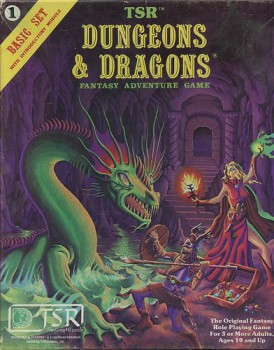 9A. Erol Otus: Otus is an oddity as he’s the only real original TSR artist to make this list [because I can’t really put Trampier as one of the TSR ‘First Four’ ala Dee, Willingham, Otus, and Roslof]. Otus, however, did make a huge impact with his inherently odd style and has become something of an OSR icon to which all Grognard folk bow. He has also seen some resurgence in recent years with the rise of Goodman Games and their Dungeon Crawl Classics line. I applaud Otus for keeping his style and staying true to his roots, so an inclusion on this list is a worthy honor.
9A. Erol Otus: Otus is an oddity as he’s the only real original TSR artist to make this list [because I can’t really put Trampier as one of the TSR ‘First Four’ ala Dee, Willingham, Otus, and Roslof]. Otus, however, did make a huge impact with his inherently odd style and has become something of an OSR icon to which all Grognard folk bow. He has also seen some resurgence in recent years with the rise of Goodman Games and their Dungeon Crawl Classics line. I applaud Otus for keeping his style and staying true to his roots, so an inclusion on this list is a worthy honor.
Did you define a gaming line? No
Is one of your pieces a seminal work in the industry? Yes, AD&D Deities & Demigods – TSR
Has your work appeared in three game lines and three companies? No
Has your presence lasted inside the industry for more than a decade? Yes [1978-Present]
Even if not known by name, is your style unique enough that it is readily identifiable above the background noise of the industry as a whole? Yes
Did a company build their brand around you? Yes, D&D Basic [2nd Edition] – TSR
Final Rating: 4 out of 6
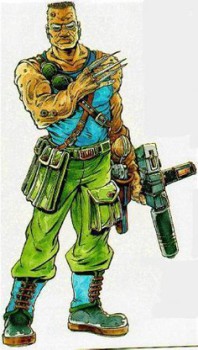 8. Jeff Laubenstein: This might be a controversial pick to some as Laubenstein’s work polarizes many gaming art fans into either love or hate camps, as well as the fact that he was never prolific in his cover design, however I think I have a strong argument for his inclusion so have a listen. The FASA Corporation was arguably the 2nd biggest game design warehouse of the 80s and 90s and although it had a stable of in-house artists, none of them had the eventual tenure of Laubenstein who started in 1985 and went through 2000, just a year before their dissolution. His work appeared in every product the company ever created after his hiring, and he was the driving force for the design of the groundbreaking cyberpunk Shadowrun RPG in which he was responsible for all the iconic archtypes as well as a multitude of NPCs archtypes. Top that with his art direction and design of Earthdawn, and his artwork that helped create that universe, and he hits on many requirements for this list.
8. Jeff Laubenstein: This might be a controversial pick to some as Laubenstein’s work polarizes many gaming art fans into either love or hate camps, as well as the fact that he was never prolific in his cover design, however I think I have a strong argument for his inclusion so have a listen. The FASA Corporation was arguably the 2nd biggest game design warehouse of the 80s and 90s and although it had a stable of in-house artists, none of them had the eventual tenure of Laubenstein who started in 1985 and went through 2000, just a year before their dissolution. His work appeared in every product the company ever created after his hiring, and he was the driving force for the design of the groundbreaking cyberpunk Shadowrun RPG in which he was responsible for all the iconic archtypes as well as a multitude of NPCs archtypes. Top that with his art direction and design of Earthdawn, and his artwork that helped create that universe, and he hits on many requirements for this list.
Did you define a gaming line? Yes, Shadowrun – FASA, Earthdawn – FASA
Is one of your pieces a seminal work in the industry? Yes, Shadowrun Iconic Archtypes – FASA
Has your work appeared in three game lines and three companies? Yes, Battletech – FASA, Mage the Ascension – White Wolf, HARP – I.C.E.
Has your presence lasted inside the industry for more than a decade? Yes [1985-Present]
Even if not known by name, is your style unique enough that it is readily identifiable above the background noise of the industry as a whole? Yes
Did a company build their brand around you? No
Final Rating: 5 out of 6
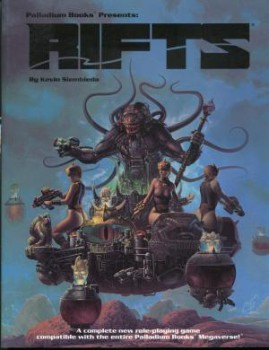 7. Keith Parkinson: Keith is another one who benefits from ‘Big Four’ syndrome, but in his case he’d be George Harrison, a man with talent enough to branch out from the shadow of TSR and create his own brand and name with a list of ‘#1 hits’ in his own right. He was never one that got Elmore or Easley props, but he had a style that he continued to evolve and hone until it turned from very, very good into simply outstanding. He was lost too soon to the industry and yet his legacy is something many artists have used to try to model their own careers.
7. Keith Parkinson: Keith is another one who benefits from ‘Big Four’ syndrome, but in his case he’d be George Harrison, a man with talent enough to branch out from the shadow of TSR and create his own brand and name with a list of ‘#1 hits’ in his own right. He was never one that got Elmore or Easley props, but he had a style that he continued to evolve and hone until it turned from very, very good into simply outstanding. He was lost too soon to the industry and yet his legacy is something many artists have used to try to model their own careers.
Did you define a gaming line? Yes, Gamma World 3rd Edition – TSR
Is one of your pieces a seminal work in the industry? Yes, Gamma World 3rd Edition – TSR, Rifts – Palladium
Has your work appeared in three game lines and three companies? Yes, AD&D – TSR, Rifts – Palladium, Everquest – S&S Studios
Has your presence lasted inside the industry for more than a decade? Yes [1983-2005]
Even if not known by name, is your style unique enough that it is readily identifiable above the background noise of the industry as a whole? No [often mistaken for Elmore]
Did a company build their brand around you? Yes, Rifts – Palladium, Forgotten Realms – TSR
Final Rating: 5 out of 6
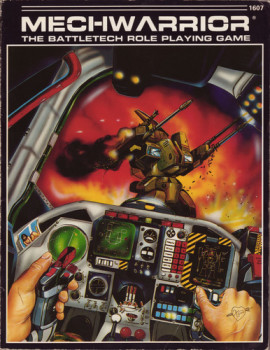 6. Jim Holloway: I’m sure many folks are surprised by how high Jim places on this list, if not that he made it at all, but if there is one thing I can say for Jim it is that through sheer perseverance he somehow has been in every RPG ever created. Yes, that is a joke, but damned if it doesn’t seem like it! Jim is an incredibly talented artist, and on top of that is fast as lightning which often makes him the ideal choice for many young enterprising companies looking to meet a deadline. He has covered some incredible works like TSR’s Desert of Desolation series, Battletech’s Mechwarrior core and supplements, GangBusters, Boot Hill, and of course Paranoia. To me, his ability to bring a homespun gaming humor to his work often outweighs the serious quality he can also show us, like his battle scenes, but there is no doubt after looking at his resume just how important Jim has been to the genre for the past thirty years.
6. Jim Holloway: I’m sure many folks are surprised by how high Jim places on this list, if not that he made it at all, but if there is one thing I can say for Jim it is that through sheer perseverance he somehow has been in every RPG ever created. Yes, that is a joke, but damned if it doesn’t seem like it! Jim is an incredibly talented artist, and on top of that is fast as lightning which often makes him the ideal choice for many young enterprising companies looking to meet a deadline. He has covered some incredible works like TSR’s Desert of Desolation series, Battletech’s Mechwarrior core and supplements, GangBusters, Boot Hill, and of course Paranoia. To me, his ability to bring a homespun gaming humor to his work often outweighs the serious quality he can also show us, like his battle scenes, but there is no doubt after looking at his resume just how important Jim has been to the genre for the past thirty years.
Did you define a gaming line? Yes, Paranoia – West End Games, and Oriental Adventures – TSR, GangBusters – TSR
Is one of your pieces a seminal work in the industry? Yes, Mechwarrior – FASA
Has your work appeared in three game lines and three companies? Yes, AD&D – TSR, Battletech – FASA, Paranoia – West End Games, Middle-Earth Role-Playing – I.C.E.
Has your presence lasted inside the industry for more than a decade? Yes [1981-Present]
Even if not known by name, is your style unique enough that it is readily identifiable above the background noise of the industry as a whole? No, he typically gets lost in translation
Did a company build their brand around you? Yes, Paranoia – West End Games, GangBusters – TSR
Final Rating: 5 out of 6
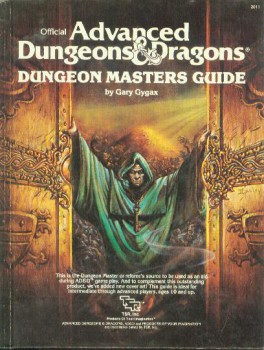 5. Jeff Easley: Many might ask why Jeff didn’t place higher on this list and truly there is only one reason, TSR. It was both his boon and his bane [in more ways than this list] but at the end of the day there is no doubt that Jeff is a singular talent who has helped create more lasting gaming memories than dozens of other very talented artists combined. He is the only artist to have defined three editions of D&D, and although 3rd Edition had no painted cover art, Jeff was the first to be used when painted cover supplements like Song and Silence, Tome and Blood, and all the class add-books came out. His work covered every single AD&D 1E hardcover core book as well as the AD&D 2E Player’s Handbook and DMG. He has also done countless b/w illustrations and there is no artist out there who has filled more RPG pages with artwork than Jeff.
5. Jeff Easley: Many might ask why Jeff didn’t place higher on this list and truly there is only one reason, TSR. It was both his boon and his bane [in more ways than this list] but at the end of the day there is no doubt that Jeff is a singular talent who has helped create more lasting gaming memories than dozens of other very talented artists combined. He is the only artist to have defined three editions of D&D, and although 3rd Edition had no painted cover art, Jeff was the first to be used when painted cover supplements like Song and Silence, Tome and Blood, and all the class add-books came out. His work covered every single AD&D 1E hardcover core book as well as the AD&D 2E Player’s Handbook and DMG. He has also done countless b/w illustrations and there is no artist out there who has filled more RPG pages with artwork than Jeff.
Did you define a gaming line? Yes, AD&D hard cover rule books – TSR
Is one of your pieces a seminal work in the industry? Yes, AD&D DMG [Reprint] – TSR
Has your work appeared in three game lines and three companies? No, just TSR
Has your presence lasted inside the industry for more than a decade? Yes [1982-Present]
Even if not known by name, is your style unique enough that it is readily identifiable above the background noise of the industry as a whole? Yes
Did a company build their brand around you? Yes, AD&D, SpellJammer, AD&D 2E, Al-Qadim – All TSR
Final Rating: 5 out of 6
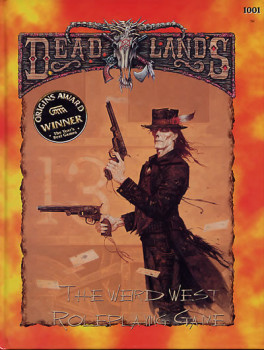 4. Brom: One of only four artists to gain the illusive ‘6 for 6’ tag from the committee, Brom began his career with TSR doing some supplement work for Spelljammer and then moved on to revolutionize Dark Sun as the cover artist. His darker and edgier style was a divergence from 1980s TSR and helped launch him into the field as a much sought after cover man for the new breed of dark fantasy settings hitting the markets. Although his style helped him, there is no doubt that sheer talent moved him up this list by leaps and bounds. Brom is arguably one of the greatest pure fantasy talents of his generation, and he still creates works just as sublime as he did in his 1990s glory.
4. Brom: One of only four artists to gain the illusive ‘6 for 6’ tag from the committee, Brom began his career with TSR doing some supplement work for Spelljammer and then moved on to revolutionize Dark Sun as the cover artist. His darker and edgier style was a divergence from 1980s TSR and helped launch him into the field as a much sought after cover man for the new breed of dark fantasy settings hitting the markets. Although his style helped him, there is no doubt that sheer talent moved him up this list by leaps and bounds. Brom is arguably one of the greatest pure fantasy talents of his generation, and he still creates works just as sublime as he did in his 1990s glory.
Did you define a gaming line? Yes, Dark Sun – TSR
Is one of your pieces a seminal work in the industry? Yes, Deadlands Core 1E Cover – Pinnacle
Has your work appeared in three game lines and three companies? Yes, D&D – TSR, Deadlands – Pinnacle, Freeport – Green Ronin
Has your presence lasted inside the industry for more than a decade? Yes [1990-Present]
Even if not known by name, is your style unique enough that it is readily identifiable above the background noise of the industry as a whole? Yes
Did a company build their brand around you? Yes, Deadlands – Pinnacle
Final Rating: 6 out of 6
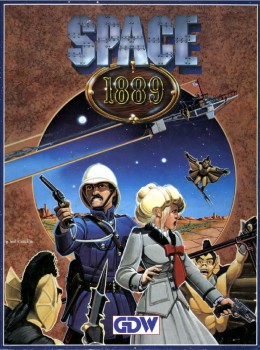 3. David Deitrick: Initially, the inclusion of David Deitrick on this list didn’t jump right out at me, but as I began making the category questions I was more and more drawn to Deitrick’s work and just how solid his place was in the annals of gaming lore. I was pleasantly amazed that David’s work not only held up when placed against the likes of the other artists on this list but also surpassed many. In the end, he stood tied with three other artists at a complete 6 for 6 rating, and although I couldn’t place him above the likes of Elmore and Reynolds, I did feel he stood above Brom for two reasons. 1: He managed a 6 for 6 and never worked for TSR, ever, which is astonishing, or had a Magic card from WotC! [Epic Fail on the part of Magic BTW] and 2: He worked only in science fiction RPGs which are inherently the ugly red-headed step child of the industry. To accomplish a 6 for 6 like that is an achievement that has me shaking my head, but I applaud this fantastic artist for his work on Traveller, Renegade Legion, Battletech, Star Trek, Dr. Who, Space: 1889, and Star Wars, which in itself is an incredibly impressive list.
3. David Deitrick: Initially, the inclusion of David Deitrick on this list didn’t jump right out at me, but as I began making the category questions I was more and more drawn to Deitrick’s work and just how solid his place was in the annals of gaming lore. I was pleasantly amazed that David’s work not only held up when placed against the likes of the other artists on this list but also surpassed many. In the end, he stood tied with three other artists at a complete 6 for 6 rating, and although I couldn’t place him above the likes of Elmore and Reynolds, I did feel he stood above Brom for two reasons. 1: He managed a 6 for 6 and never worked for TSR, ever, which is astonishing, or had a Magic card from WotC! [Epic Fail on the part of Magic BTW] and 2: He worked only in science fiction RPGs which are inherently the ugly red-headed step child of the industry. To accomplish a 6 for 6 like that is an achievement that has me shaking my head, but I applaud this fantastic artist for his work on Traveller, Renegade Legion, Battletech, Star Trek, Dr. Who, Space: 1889, and Star Wars, which in itself is an incredibly impressive list.
Did you define a gaming line? Yes, Star Trek – FASA, Battletech – FASA, Space: 1889 – GDW
Is one of your pieces a seminal work in the industry? Yes, Space: 1889 – GDW
Has your work appeared in three game lines and three companies? Yes, BattleTech – FASA, Star Wars – West End Games, Space: 1889 – GDW
Has your presence lasted inside the industry for more than a decade? Yes [1982-Present]
Even if not known by name, is your style unique enough that it is readily identifiable above the background noise of the industry as a whole? Yes, is there any mistaking a Deitrick marker?
Did a company build their brand around you? Yes, Space 1889 – GDW
Final Rating: 6 out of 6
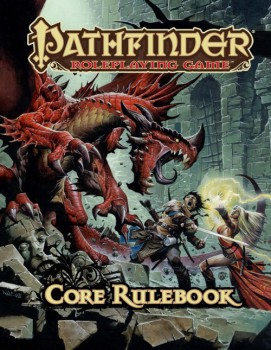 2. Wayne Reynolds: I recently did a full article on Wayne, so some of that will be reiterated here, but the bottom line is we’ve never, ever, seen the kind of dominance of a genre like what Wayne began with Eberron in the early 2000s. Since he started getting covers, his artwork has gone on to champion two of the largest gaming lines and companies the genre has ever known. He is also prolific, even though his work appears mostly on covers, and the only artist I’m aware of who has more RPG covers than Reynolds is Jeff Easley who was a primary cover artist for TSR for twenty solid years. The next phase for Wayne will be his transition from the forefront of Paizo and WotC to another game or company, as his strangle-hold will at some point have to abate, but to this point it hasn’t happened, so there is no mistaking his longevity to this point in his career.
2. Wayne Reynolds: I recently did a full article on Wayne, so some of that will be reiterated here, but the bottom line is we’ve never, ever, seen the kind of dominance of a genre like what Wayne began with Eberron in the early 2000s. Since he started getting covers, his artwork has gone on to champion two of the largest gaming lines and companies the genre has ever known. He is also prolific, even though his work appears mostly on covers, and the only artist I’m aware of who has more RPG covers than Reynolds is Jeff Easley who was a primary cover artist for TSR for twenty solid years. The next phase for Wayne will be his transition from the forefront of Paizo and WotC to another game or company, as his strangle-hold will at some point have to abate, but to this point it hasn’t happened, so there is no mistaking his longevity to this point in his career.
Did you define a gaming line? Yes, Pathfinder – Paizo, D&D 4E – WotC, Eberron – WotC
Is one of your pieces a seminal work in the industry? Yes, Pathfinder Core – Paizo
Has your work appeared in three game lines and three companies? Yes, Pathfinder – Paizo, D&D – WotC, Freeport – Green Ronin
Has your presence lasted inside the industry for more than a decade? Yes [1998-Present]
Even if not known by name, is your style unique enough that it is readily identifiable above the background noise of the industry as a whole? Yes
Did a company build their brand around you? Yes, Pathfinder – Paizo, D&D 4E – WotC, Eberron – WotC, Freeport – Green Ronin
Final Rating: 6 out of 6
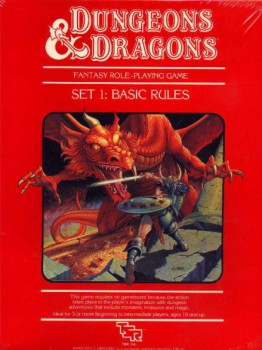 1. Larry Elmore: Without a doubt, artist Larry Elmore is the Frazetta of RPG artwork, the foundation of which a genre has been built. There is a great story I’ve heard about his time at TSR when the company would bring in VIPs and take them to the art department, bypass all the other incredible artists working there to get to Larry’s desk in the back and then say ‘And here is Larry Elmore, the greatest fantasy artist in the world!’. Mind you, Jeff Easley, Harry Quinn, Jim Holloway, Tim Truman, Keith Parkinson, and Clyde Caldwell would have to be passed up just to get to Larry. Now I’m not sure I’m jumping on the coattails of the TSR management crew, but I will say Elmore not only helped define a good portion of 1980s TSR, but he also got to do the Shadowrun core cover for FASA that was so incredibly popular it reappeared on the 2nd edition and video game as well. Now Elmore might not have had the mass crossover company line that Wayne Reynolds has, but he’s also been active in the industry almost two decades more, so for that reason he’s going up to #1 on the list.
1. Larry Elmore: Without a doubt, artist Larry Elmore is the Frazetta of RPG artwork, the foundation of which a genre has been built. There is a great story I’ve heard about his time at TSR when the company would bring in VIPs and take them to the art department, bypass all the other incredible artists working there to get to Larry’s desk in the back and then say ‘And here is Larry Elmore, the greatest fantasy artist in the world!’. Mind you, Jeff Easley, Harry Quinn, Jim Holloway, Tim Truman, Keith Parkinson, and Clyde Caldwell would have to be passed up just to get to Larry. Now I’m not sure I’m jumping on the coattails of the TSR management crew, but I will say Elmore not only helped define a good portion of 1980s TSR, but he also got to do the Shadowrun core cover for FASA that was so incredibly popular it reappeared on the 2nd edition and video game as well. Now Elmore might not have had the mass crossover company line that Wayne Reynolds has, but he’s also been active in the industry almost two decades more, so for that reason he’s going up to #1 on the list.
Did you define a gaming line? Yes, D&D Basic [Red Box] – TSR, Dragonlance – TSR
Is one of your pieces a seminal work in the industry? Yes, D&D Basic [Red Box] – TSR, Shadowrun 1E/2E – FASA, Star Frontiers – TSR
Has your work appeared in three distinct game lines and three companies? Yes, AD&D – TSR, Dangerous Journeys – GDW, Shadowrun – FASA
Has your presence lasted inside the industry for more than a decade? Yes [1982-Present]
Even if not known by name, is your style unique enough that it is readily identifiable above the background noise of the industry as a whole? Yes, Elmore is an Elmore, even if it is a Parkinson or Caldwell.
Did a company build their brand around you? Yes, Shadowrun – FASA, Dangerous Journeys – GDW, D&D Basic [Red Box] – TSR
Final Rating: 6 out of 6
If you like what you read in Art of the Genre, you can listen to me talk about publishing and my current venture with great artists of the fantasy field or even come say hello on Facebook here. And my current RPG Art Blog can be found here.
Personally, I think Trampier’s stuff (especially his pen and ink) is pretty identifiable.
no diterlizzi? lamentable.
For shame. Where is David Sutherland III? Monster Manual, DMG, D&D Basic Set.
I don’t know how they’d chart based on the criteria, but I’d like to throw a shout-out to William Keith and Paul Jaquays for their work on Traveller — their ship illustrations were iconic.
Interesting list! I’ll cop to not being a big fan of the Easley/Elmore/Caldwell brand of painted art. I’m not sure why, but even as I recognise the technical skill, the images somehow don’t speak to me. Maybe it’s because I got into D&D when Trampier and the line-art folks were still the vogue, and it’s that style that really says ‘RPG’ to me.
How do you think Russ Nicholson would rank? The original cover art for the Fiend Folio, a lot of art for the Fighting Fantasy books, all that Warhammer stuff … and that’s just what I know of. Looking at the profile on his blog he mentions having done art for Runequest, Goodman Games, and Kobold Press. Very recognisable stylist. What do you think? (And if not him, what about John Blanche?)
I’ll give my two cents.
As a kid, I hated Erol Otus’ artwork. It seemed to me that all of his creatures–people and monsters–looked like genetic cousins to Peter Lorre. However, I now love his artwork–then and now. Probably for nostalgia reasons alone.
As a contrast, as a kid I loved Jeff Dee’s work, especially his work on his game Villains and Vigilantes. But I think his current work isn’t near as good as the old stuff. His old lines were cleaner and less busy than his new stuff. This particularly stands out if you see his Kickstarter remakes of older DnD stuff.
Thanks for the post!
TW: Tramp is certainly identifiable to someone who loves Tramp, but take on of his Star Frontiers pieces and hand it to a game today and they’d be hard pressed to name the artist, or even what he’d done. That is the key to unique quality.
Philby: I actually did a pre-lim list and had DeTerlizzi on it, but once I plugged in the formula he fell off the list. Here was his ranking:
Tony DiTerlizzi [TSR-Planescapes]:
Did you define a gaming line? Yes, Planescape
Is one of your pieces a seminal work in the industry? No
Has your work appeared in three game lines and three companies? No
Has your presence lasted inside the industry for more than a decade? Questionable, once leaving TSR he didn’t overtly do gaming work, especially after becoming a children’s book author.
Even if not known by name, is your style unique enough that it is readily identifiable above the background noise of the industry as a whole? Yes
Did a company build their brand around you? No, he didn’t even get Planescape, that cover art went to Robh Ruppel.
Final Ranking: 2 out of 6
Sorry for the necromancy, but I came across this article while going down a Wikipedia wormhole.
Did you define a gaming line? Yes, Planescape, Changeling
Is one of your pieces a seminal work in the industry? No
Has your work appeared in three game lines and three companies? Yes, D&D (TSR), Changeling, Werewolf (White Wolf), Magic: the Gathering (Wizards)
Has your presence lasted inside the industry for more than a decade? Yes, with his work in both Changeling and Magic
Even if not known by name, is your style unique enough that it is readily identifiable above the background noise of the industry as a whole? Yes
Did a company build their brand around you? Yes, Changeling’s entire aesthetic was DiTerlizzi.
So, 5/6.
chartmapcounter: Sutherland is an old school guy, but he was never ‘the guy’ at TSR. His Basic D&D work was overshadowed by both Otus and Elmore, his DMG didn’t lead the AD&D line, that was Trampier’s Player’s Handbook that released a year before the Sutherland DMG, and other than the three things you mentioned he has little to show that says ‘Top 10’ as he was relegated to making maps at TSR after the 1981 purge.
Joe H: You know my problem with Traveller? It should be evident, THEY HAD BLANK PANEL COVERS! Until David Deitrick livened the art up in that game, it was really just ship design, and although talented, ships design can’t really add much to an artists overall portfolio, however Jaquays cover for Dragon Mountain is iconic to me, but not enough people would recognize it also.
Matthew David Surridge: I love Russ personally, and have used him in both my issues of Gygax thus far, but he can’t make it on the list because he hasn’t done enough covers and hasn’t led a line. As for Fiend Folio, he did incredible work in the book, but the cover is by Emmanuel, not Russ 🙁
James McGlothlin: You aren’t alone in your feeling about Erol, I echo them wholeheartedly. It is nostalgia that drives the current passion for Erol’s work more so than his overall talent level in the craft, but as long as Erol does Erol, there are OSGers who will line up to buy his stuff. Both Dee and Willingham had great comic book chops in 1981, but both have moved on to writing careers and Willingham no longer draws anything and Dee prefers not to, so their art has obviously taken a hit on that count.
Wayne Reynolds became my favorite artist without me even realizing it for awhile.
His action scenes are so fluid you can see them come to life as you look at each work.
His artwork alone is the reasons i ended up taking a closer look at the Eberron setting.
The colors he uses and how he brings everything to life makes him top notch.
Scott: Argh, I actually knew that about Emmanuel. Shows what comes of me getting up early to watch Olympic hockey.
Yeah, the original Little Black Book Traveller had maybe one illustration? They did include more in the various adventures & supplements, but it wasn’t until they abandoned the digest-sized format that they started increasing the volume of illustrations. (And that was around the time that they started using Dietrick’s work, I believe.)
I do have to say I liked the text-only covers on the original digest-sized books, although that does kind of exclude them from the art discussion.
Glenn: No doubt about Reynolds, he certainly has defined a generation of gamers.
Matthew: I’ll give you a pass… this time! 😉
Joe H: Art for the sake of design, yes, Traveller is pretty cool, but in an artist list it gets the old ‘epic fail’ 🙂
[…] Recent Black Gate Press Article – […]
What about Jeff Dee.
Icon of TSR and many other companies through the early days to current, his art plastered on many a cover of many modules, and pretty much responsible for sales across the board for much of the industry.
He fits all of your criteria I see.
Torin: I swear to god, if one more person brings up Jeff Dee I’m going to have to write a ‘Why Jeff Dee is awesome, but not the worlds greatest artist’ post for next Wednesday.
I’m of an age that Trampier and Otus defined the look of D&D for me. Dee was a distant third.
Actually, fourth after Tom Wham. His art is a beautiful reminder of the beginnings of gaming and it’s less corporate/professional beginnings.
its
Fletcher: I love Tom Wham! I often wonder if his art influenced the powers that be to bring Will McLean in to do DMG comics.
Probably. In my heart, if it’s not by Trampier, I want my gaming art to be as fun and as “primitive” as Wham or McClean
What about Gene Day? While better known for his comic art he did iconic work for Runequest, Tunnels & Trolls, Space Opera, Call of Cthulhu. Unfortunately he passed away in 1982 at only 31.
Chart: Another one taken far too soon…
[…] Top 10 RPG Artists of the Past 40 Years’ and if you haven’t taken a look, I hope you can right here! Oh, and remember, it isn’t who is the ‘best’ but how was the most […]
[…] that had a Halfling in the background. As two weeks ago I’d done a piece here on BG called ‘The Top 40 RPG Artists of the Past 40 Years’, AND had left Jeff off that list, I couldn’t help but stare at the image and wonder why I had […]
Some more artists:
Russ Nicholson
1. Defining a gaming line: WFRP 1 (if not Russ, who else?)
2. Seminal Work: (maybe Githyanki an Githzerai)
3. 3Lines & Companies: WFRP 1 – Hogeshead, Lamentations of the Flames Princess, DCC RPG – Goodman Games,
4. Lasting: Yes [1989 or earlier – present]
5. Unique Style: Yes
6. Brand around you: french version of Dungeon World
=> 5 to 6 out of 6
William O’Connor
1. Defining a gaming line: D&D 4 (much more than any other artist)
2. Seminal Work: D&D 4 classes (PHB I)
3. 3Lines & Companies: L5R – AEG, D&D 4 – WotC, Star Wars – FFG
4. Lasting: Yes [1999 – Pesent]
5. Unique Style: Yes
6. Brand around you: D&D 4
=> 6 out of 6
Jon Hodgson
1. Defining a gaming line: The One Ring
2. Seminal Work: Cover for Dragon Warriors Core(new Version)
3. 3Lines & Companies: The One Ring – Cubicle7, Das Schwarze Auge – Ulisses Spiele, All Flesh must be eaten – Eden Studios
4. Lasting: Yes [2001 – Pesent]
5. Unique Style: Yes
6. Brand around you: The One Ring, Dragon Warriors (new version)
=> 6 out of 6
John Blanche
1. Defining a gaming line: Dark Heresy
2. Seminal Work: [maybe] the dying of the light (cover), Empire in Flames (cover)
3. 3Lines & Companies: WFRP1 – Hogshead, (british version of) Runequest3 – GW , Dark Heresy – Fantasy Flight
4. Lasting: Yes [1979 – Pesent]
5. Unique Style: Yes
6. Brand around you: 40K in general not just Dark Heresy
=> 5 out of 6
Peter Mullen
1. Defining a gaming line: Swords & Wizardry
2. Seminal Work: Torchbearer (Cover), S&W White Box (Cover), Swords & Wizardry Core
3. 3Lines & Companies: Swords & Wizardry – Mythmere Games, DCC RPG – Goodman Games, Torchbearer – Burning Wheel
4. Lasting: No [2006 – Present]
5. Unique Style: Yes
6. Brand around you: Swords & Wizardry
Pat Loboyko
1. Defining a gaming line: Witch Hunter
2. Seminal Work: –
3. 3Lines & Companies: WFRP 2nd – Black Industries/GW, Witch Hunter – Paradigm Concepts, nWoD – White Wolf
4. Lasting: No [2002 – Present]
5. Unique Style: Yes
6. Brand around you: Witch Hunter
=> 5 out of 6
Ralph Horsley
1. Defining a gaming line: difficult. Maybe WFRP1 + 2 combined (Covers for WFRP2, Interiors for WFRP1), Maybe D&D 4 Essentials
2. Seminal Work: WFRP 2nd Tome of Corruption?
3. 3Lines & Companies: D&D 3 & 4 – WotC, WFRP 1+2 – GW/Hogshead, Ars Magica 4th – Atlas Games
4. Lasting: Yes [1994 – Present]
5. Unique Style: Yes
6. Brand around you: D&D 4 (Essentials)? – at least as much as around Mr Reynolds!
=> somewhere between 3 and 6 out of 6
… what I wanted to show: Your List mostly covers the Top Artists, that defined the Hobby from the mid 80ies to the late 90ies. But there is much more to discover
[…] Art of the Genre: The Top 10 RPG Artists of the Past 40 Years […]